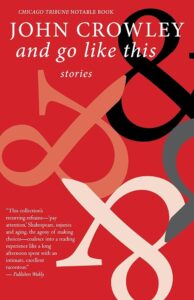And Go Like This collects nine works of Crowley’s shorter fiction that were originally published between 2002 and 2018, plus the final story “Anosognosia” — when a person cannot recognize that they have a disability because of an underlying condition — which was published for the first time in this volume. They range in length from one page (“In the Tom Mix Museum”) to about 60 (“The Girlhood of Shakespeare’s Heroines” and the three parts of “Mount Auburn Street”). They range in genre from fantasy tinged by myth and history (“Flint and Mirror”) to science fiction (“And Go Like This,” “Spring Break” and “Conversation Hearts”) to ostensibly mundane (“Mount Auburn Street” again) to stories that, looking back, I have a hard time fitting into a category (“The Girlhood of Shakespeare’s Heroines” and “This Is Our Town”).
Crowley’s writing is never less than congenial, and he conjures scenes with apparent ease, whether they are the mid-century America of “Mount Auburn Street” or the allegorical aliens of “Conversation Hearts” or the nearish future dystopia of “Spring Break.” Some of the stories, like the title tale, have twist endings; others have more ambiguous stoppings, trailing off almost mid-incident and letting readers decide what happens next. If there’s a common aspect, it’s a slight stand-offisheness, an authorial distance from the events of the stories. Some writers are direct and visceral; Crowley is not one of them, at least not here.
I find that he’s difficult for me to write about because on the one hand there’s so much to say, and on the other his diffidence is slightly contagious: here is the work, take it or leave it. I’ve been reading Crowley for more than 40 years, but always steadily, never at a fever pitch. He’s best known for his fourth novel, Little, Big, and it’s a vast and engrossing work, a multi-generational saga that consorts with the ineffable and also has me quite believing that some of the characters can converse with a trout. I’m re-reading it now, slowly, with the turn of the seasons as my measure of time, and I cannot say how many times I have read it since I first picked up the Bantam edition from 1983. Then I went back and read his first three — The Deep, Beasts, and Engine Summer — and liked them all, especially for their very different atmospheres. I also thought that I could feel in those three how he was writing Little, Big all along.
Those are the Crowley books that I love. After that, my reactions are more mixed. The Translator is an engrossing and charming story from the Cold War; I read it quickly and would happily go back. Lord Byron’s Novel: The Evening Land is somewhere, carried along as I moved from country to country. I think I tried it once or twice, and the time was not right. I read Ægypt when it was new, long before it was revised in 2007. Given the description and the title, I was hoping for something like another Little, Big and it was, but it also wasn’t. It turned out to be the first volume in a four-book set, completed and published over the course of 20 years. The other volumes are Love & Sleep, Dæmonomania and Endless Things. In them, Crowley explores interlocking themes of the magical and the mundane, of past and present — particularly that changes in eras can remake the past, about boundaries between life and fiction. I was uncertain about Love & Sleep, I struggled to get through Dæmonomania, and I have yet to crack my copy of Endless Things. I read between a third and half of Four Freedoms when I was in the hospital with appendicitis in 2020, and it was a polished story of life on the home front in America during World War II. I can still remember scenes and some of the action, but I all the same I have not felt compelled to pick it back up to read the rest. “Great Work of Time” is brilliant, a meditation on time travel that I still recall probably 30 years after I read it. I just looked at the table of contents of Novelty, the collection I read it in, and I cannot bring back anything at all about the other three tales in the book.
His publishing history has also been complicated. I remember when I was a bookseller in the early 1990s I mentioned Crowley to one of the sales representatives, and he said that he personally loved Crowley’s work but the publishing house had trouble keeping him in print because his enthusiasts were too few and far between. Crowley’s best work is an absolute treasure, but his range is wide and readers differ on just which books are best. (Well, except for Little, Big; people who like Crowley at all generally think that one best.) And so the books prior to Little, Big are in an omnibus titled Otherwise, while Novelty has been subsumed in Novelties and Souvenirs. The others are scattered across publishers and imprints. Electronic editions and online retail have helped him find a sufficient audience to keep his books in print, but he still has the feeling of an almost secret discovery.
I think that if I were starting to read Crowley now, I would begin with Novelties and Souvenirs, then the early novels, and only afterward And Go Like This.

